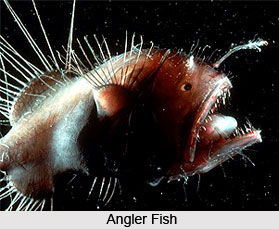 Angler fish are so called because part of their dorsal fin is modified to form a long angling `rod` complete with `bait` called the illicium. When the fish is hungry, it remains motionless on the sea bottom, waving its illicium near its gaping mouth. An unsuspecting fish investigating the worm-like wriggling movement of the bait finds itself sucked into the mouth and devoured. Near the seashore, a typical example is Antennarius, found on the west coast.
Angler fish are so called because part of their dorsal fin is modified to form a long angling `rod` complete with `bait` called the illicium. When the fish is hungry, it remains motionless on the sea bottom, waving its illicium near its gaping mouth. An unsuspecting fish investigating the worm-like wriggling movement of the bait finds itself sucked into the mouth and devoured. Near the seashore, a typical example is Antennarius, found on the west coast.
In the deep sea, we have nearly a hundred species of anglers of the suborder Ceratioidei. Their illicium varies from a stubby lobe to a whip several times longer than the fish. Usually the tip is luminous and emits flashes of light to attract the prey.
In the dark oceans where life is never abundant, a major problem is finding a mate. Four genera of anglers have however, solved it in a unique manner. The tiny male seeks a female clamp on to her body. Its jaws and tongue grow into her tissues and fuse with them. The male`s digestive tract now degenerates, and it gets its nourishment via the female`s blood circulation. In fact the male virtually becomes a sperm-producing factory. As many as four males fuse with a female, anywhere on her body - the belly, head or gill-cover - and fertilize her eggs when laid.
This article is a stub. You can enrich by adding more information to it. Send your Write Up to content@indianetzone.com



















